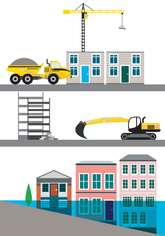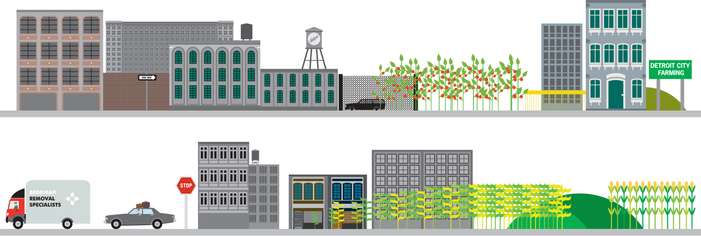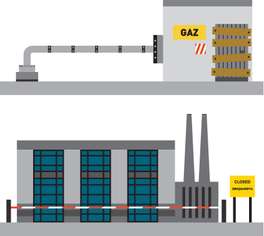Abandoned cities / Global
Please turn off the lights
Do cities have a sell-by date? And if they no longer feel fresh and vital, should we abandon them? That’s what’s happening in Russia. So should the burghers of New Orleans and Detroit do the same?
Should cities that have lost their purpose be abandoned? Should a metropolis that stands in the way of hurricanes or earthquakes be handed over to nature? It’s a question few are brave enough even to ask – no mayor wants to be the official who turns the lights out on their community.
But Timothy Kusky, professor of natural sciences at St Louis University, believes that’s what should – and will – happen in New Orleans. “We should not be rebuilding New Orleans,” says Kusky. “Let the areas that were destroyed by Katrina – and will be next time – return to nature and rebuild the city on higher ground to the north of Lake Pontchartrain, along the river. It could be a gradual withdrawal.”
In his 2008 book The Coast, Kusky notes that New Orleans has been “levelled or deeply inundated by hurricane-related flood waters about once every 30 years since its founding in 1715”. It is difficult to resist invoking Einstein’s definition of insanity – doing the same thing repeatedly and expecting different results. “Eventually,” says Kusky, “most of New Orleans will become uninhabitable. It will be a slow process, with people and businesses leaving slowly over 100 to 200 years.”
Every city that exists does so because it was possible to sink its foundations in logic. It seems self-evident that this will not always be the case – times change, societies change, economies change.
Yet while human beings are ruthless in discarding obsolete technologies, politics and fashions, we do not give up on cities easily. Even amid the tumult and violence of modern European history, it is possible to point to only one completely abandoned modern city. Pripyat, in what is now Ukraine, was rapidly and permanently evacuated after the 1986 explosion at the nearby Chernobyl nuclear plant.
Elsewhere, however, governments and people continue to pour money and energy into cities that, from any rational perspective, also appear to have outlived their usefulness. The US government has spent billions attempting to prop up America’s car giants, and, by extension, the city of Detroit – where unemployment has nevertheless rocketed from 3.7 per cent to 9.7 per cent just this decade.
Detroit has become an almost proverbial shorthand for the creeping malaise of the US’s industrial centre and of the cities it once nourished. But as long ago as 1961, a hand-wringing article on Detroit in Time magazine bemoaned the collapse of car sales, rampant unemployment and fleeing population, and Detroit still survives. However bad it might be, it clearly isn’t sufficient to frighten off everybody.
“It depends how you define bad,” says Ashley Atkinson. Atkinson is director of project development at The Greening of Detroit, an NGO whose mission to transform the motor city into the model for a green urban future. “If you love suburbia and consumerism, you’ll think Detroit is a terrible place. If you like real-life communities, you’ll love it.” In defiance of every statistical analysis, Atkinson is optimistic about Detroit. “The spirit of people who choose to stay here is amazing,” she says. We embrace the uncomfortable. We find humanity in it. We’re trying to build a city that is less sick than the others.” She sees no reason to abandon Detroit to the weeds.
This belief that decay freights possibility is even more pronounced in Braddock, Pennsylvania – a dilapidated borough of Pittsburgh, another famously dwindling American city (although in a bid to prop it up, it gets to host the G2o summit this autumn). Braddock’s official website declares “Destruction breeds creation”. The combative tone is personified by Braddock’s mayor John Fetterman. Fetterman wears his concerns for his adopted hometown not so much on his sleeves as beneath them: he has the town’s zip code tattooed on one arm and the dates of murders that have occurred during his term down the other, a constant reminder of the work still to be done. “By some measurements,” he admits, “Braddock would be considered a ghost town. It had a population of 20,000 in the 1940s, and it’s under 3,000 now.”
It is, he continues, the kind of place where you can buy an eight-storey building for $16,000 – and he’s hopeful that people can be persuaded to do exactly that. “Braddock,” he declares, “is an excellent opportunity for people who want to get involved, rather than just renting an apartment in Manhattan and living a typical life. It’s not easy, but it’s rewarding.






I don’t think you should ever give up on a community. I challenge anyone to find a town with more strikes against it than Braddock, but I love it here.”
Yet despite the rallying cries of NGOs and mayors, many cities in the developed world, especially in Eastern Europe, seem doomed to disappear from the map as people simply pack up and leave in search of better lives – or don’t have enough children to sustain the city.
In its latest report, the United Nations Human Settlement Programme (UN-HABITAT) says that 100 Russian and 40 Ukrainian cities suffered population loss in the 1990s; 25 per cent of Japanese cities reduced in size during the same period. The problem is that as populations fall, services contract, quality of life diminishes and cities literally start falling apart.
What’s needed, says the report, is a new era of “smart planning for contraction”. As we abandon cities and they shrink even further, we need to find a way of reinventing them – perhaps as small towns or clusters of villages with farmland in between. Is this the destiny of Detroit? The problem is we just don’t know how to manage a city going back down the evolutionary scale from city to town, to village. But some countries are going to have to start thinking fast. Bulgaria’s population is set to fall 35 per cent by 2050. What will it do as its cities fade?
It seems, however, that no city is so wretched that some people will not try to make it work, whatever the odds. Kiruna, a mining town of 24,000 in the far north of Sweden, is terminally threatened by subsidence. Rather than giving up on it, the citizens will spend the next decade moving the entire town. Isn’t this a bit, well… crazy?
“Absolutely not,” says Richard Burdett, professor of architecture and urbanism at the London School of Economics. “Cities are where human beings live, and cities do rethink themselves. Turin reduced its manufacturing and was very creative about bringing in hi-tech industry. Barcelona reinvented itself when the port there died.”
Simon Anholt, editor of the journal Place Branding and Public Diplomacy and an adviser to several governments, believes that the power of sentiment cannot be underestimated. “If,” he says, “a place has been home to a large number of people for more than a couple of generations, the idea of it becomes powerful, it becomes magical. They won’t leave unless there is absolutely no choice.”
There is, certainly, little denying that the idea of the city is becoming more popular, not less. The UN estimates that in the last two decades, the world’s legions of urbanites have swelled by three million people a week. That represents an enormous transfusion of ambition and invention – sufficient, perhaps, to revive the most apparently sclerotic wasteland.
“Cities,” says Burdett, “have a deep cultural raison d’être that transcends economy and even environment. It takes an enormous amount to stop a city from existing.”
Good migrations Russians who came in from the cold
Inhuman temperatures, poor infrastructure, non-existent transport connections and minimal economic possibilities – when it comes to choosing the most miserable places on earth, many of Russia’s far-flung regional outposts come near the top of the list. Cities speckled across the vast icy expanses of Russia were often founded or developed by Soviet planners with no instinct for market economics and little care for human hardship.
During the Soviet era, distant regions were populated either by released gulag inmates and their descendants or by enthusiastic citizens who either wanted to build communism in the taiga, or were simply chasing the better wages often available in the hardship zones. When the Soviet Union collapsed, so did the industries and salaries. Thousands of settlements, from tiny villages to sizeable cities, struggled as their Soviet-era industries became non-profitable and millions of residents fled far northern cities, from Murmansk in the west across to Magadan in the far east, in search of better conditions.
During the 1990s, the Magadan and Chukotka regions lost half their populations, and the process has continued this decade. Between 2000 and 2007, over 400,000 people departed Siberia and the Far-Eastern Federal District for warmer climes. Some towns have been abandoned completely – take Kadykchan, a former mining town near the far-eastern centre of Magadan, which in the 1980s had a population of over 10,000. By 2003, this number had fallen to less than 500, as the mine closed and there was little other work to be found. This was when the authorities stepped in and turned off the heating, which in the Siberian climate is as good as reading the last rites. The few remaining inhabitants were given money and asked to relocate.
The process continues across Russia. Last year, in the northwestern Komi area, the local authorities began a five-year plan to close down 240 villages and towns that were ranked as “without prospects”. But there are still millions living in inhospitable towns and cities across Russia. Some residents are attached to their homes; others say they can’t afford to move.
“The regions that border China should be developed and invested in as a defence against the threat from the growing Chinese population,” says Sergey Ryazantsev, head of the Centre of Social Demography and Economic Sociology in Moscow. “But for the towns in the far north, we should move to the Canadian model, where only the number of people necessary to extract the natural resources actually live there.”
Shrink estates
How will mayors adapt?
According to the UN the populations of 46 countries, including Germany, Italy, Japan and most of the former Soviet states will diminish between now and 2050. That impact will be felt in their cities – already 40 per cent of cities in the developed world shrank between 1990 and 2000.
But as well as having an urban planning solution for this new world, mayors are also going to have to develop strategies for managing how people feel about living in a city where blocks are pulled down to make way for farms. How will civic leaders stop more and more people giving up on what could be seen as a failed urban environment? The role of mayor as city champion has never been more important.
Consigned to dust
Lost cities of antiquity
Babylon: lost in translation
For one-and-a-half millennia, Babylon survived numerous sieges and invasions. “It had a really strong central culture which adapted to all sorts of circumstances,” says Lindsay Allen, lecturer of Greek and Near Eastern history at King’s College, London. “This makes it all the more surprising that it failed in the end.” Constant turmoil and the competing power of the new capital Seleucia eventually took its toll. By 141 BC, the city had vanished.
Tikal: too much, too soon
Tikal, in modern-day Guatemala, is the largest archaeological site of the Maya civilisation. Its rapid expansion is thought to be a cause of its demise in circa 900 AD. Author of Lost Cities of the Ancient World, Joel Levy, says, “They were masters of their environment and created clever agricultural tricks ahead of their time. Population growth made them exploit less suitable and less fertile land and there was then probably a drought that pushed them over the edge.”
Cities of the Helvetii: no looking back
In 58 BC, this tribe from Switzerland left its rocky mountaintop to conquer the greener and more fertile pastures of Gaul. To motivate themselves and destroy hope of a return home, they burned down their cities and cornfields as they left. “They burnt 12 towns and 400 villages and farmsteads,” says Martin Dinter, lecturer in Latin at King’s College London. It ended in tragedy when they came up against Caesar’s army in Gaul. Hardly any of them survived.
Ephesus: muddied history
Famous in Greco-Roman antiquity as home to the Temple of Artemis, one of the Seven Wonders of the World, Ephesus on the west coast of modern-day Turkey was the epicentre of trading in Asia Minor during the first centuries AD. Professor Charlotte Roueché at King’s, who specialises in late Roman and Byzantine studies, says, “The harbour silted up and so the city’s aband- onment was a matter of pure practicality.”
Persepolis: a sitting target
Persepolis was built by King Darius I from 520 BC onwards. Its destruction is attributed to Alexander the Great, whose Macedonian army burnt most of it to the ground. “It was a really open city.
You think of ancient cities as being geared for war but Persepolis was built in a peaceful phase in history so wasn’t necessarily designed to survive,” says Lindsay Allen, author of The Persian Empire: A History.


